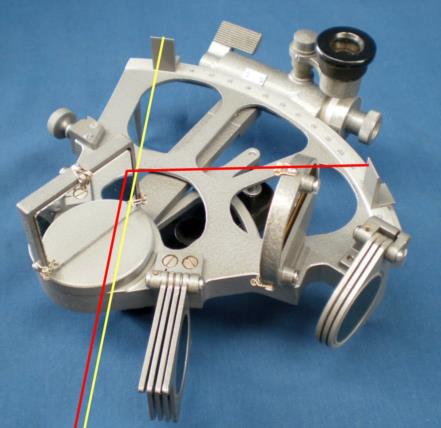
NavList:
A Community Devoted to the Preservation and Practice of Celestial Navigation and Other Methods of Traditional Wayfinding
From: Bill Morris
Date: 2014 Jan 16, 20:42 -0800
I don't understand the references to the top surfaces of the various solid objects - dice, piles of coins, pieces of Lego - in this thread as the only requirement is for two edges of equal height above the limb, very approximately of the same height as the centre of the horizon mirror. The index mirror is then adjusted so as to bring the direct image of the edge at the lower end of the limb into line with reflected image of the edge at the top end of the limb, when viewed with the eye at about the same height as the top of the vanes. "Vane" seems to be the best translation of "dioptre" in this context.
The first attached photo shows the placement of the edges and the second the view when they are lined up. In the case of the Soviet SNO-M and SNO-T sextants two vanes are provided. They are nothing more complex than two pieces of angle aluminium with the top edges filed nearly to a knife edge, leaving a narrow untouched land about 0.5 mm wide.
I am mystified as to how anyone could confuse the direct and reflected images and thus need the vanes or other objects to be of different colours. Where this might be useful is in using the vanes to collimate the telescope by lining up the tops of the vanes with some distant object such as a roof line and bringing the image of the same object into the centre of the field of view of the telescope. The third photo shows how the vanes are set up to do this.
Bill Morris
Pukenui
New Zealand
----------------------------------------------------------------
NavList message boards and member settings: www.fer3.com/NavList
Members may optionally receive posts by email.
To cancel email delivery, send a message to NoMail[at]fer3.com
----------------------------------------------------------------









